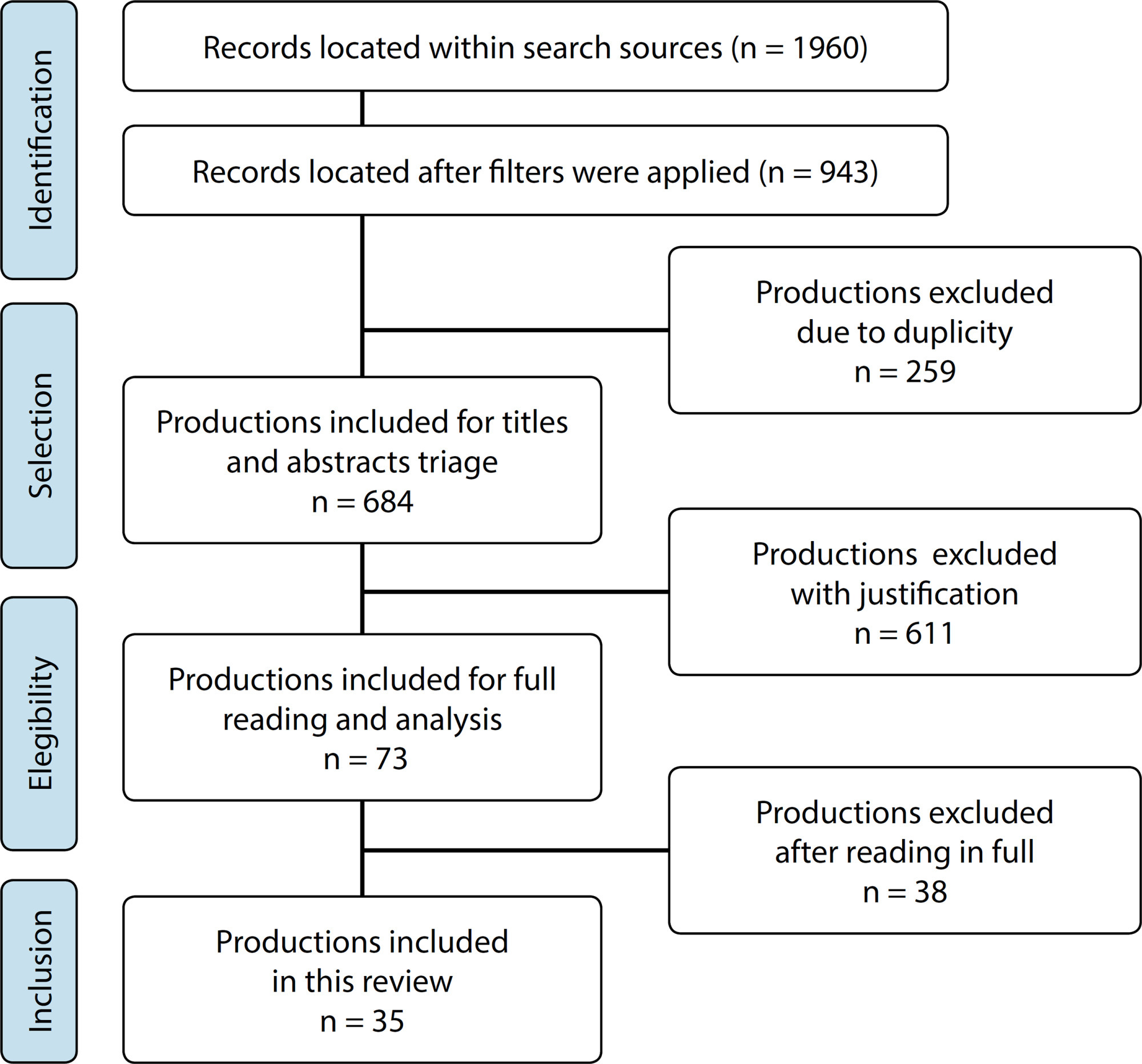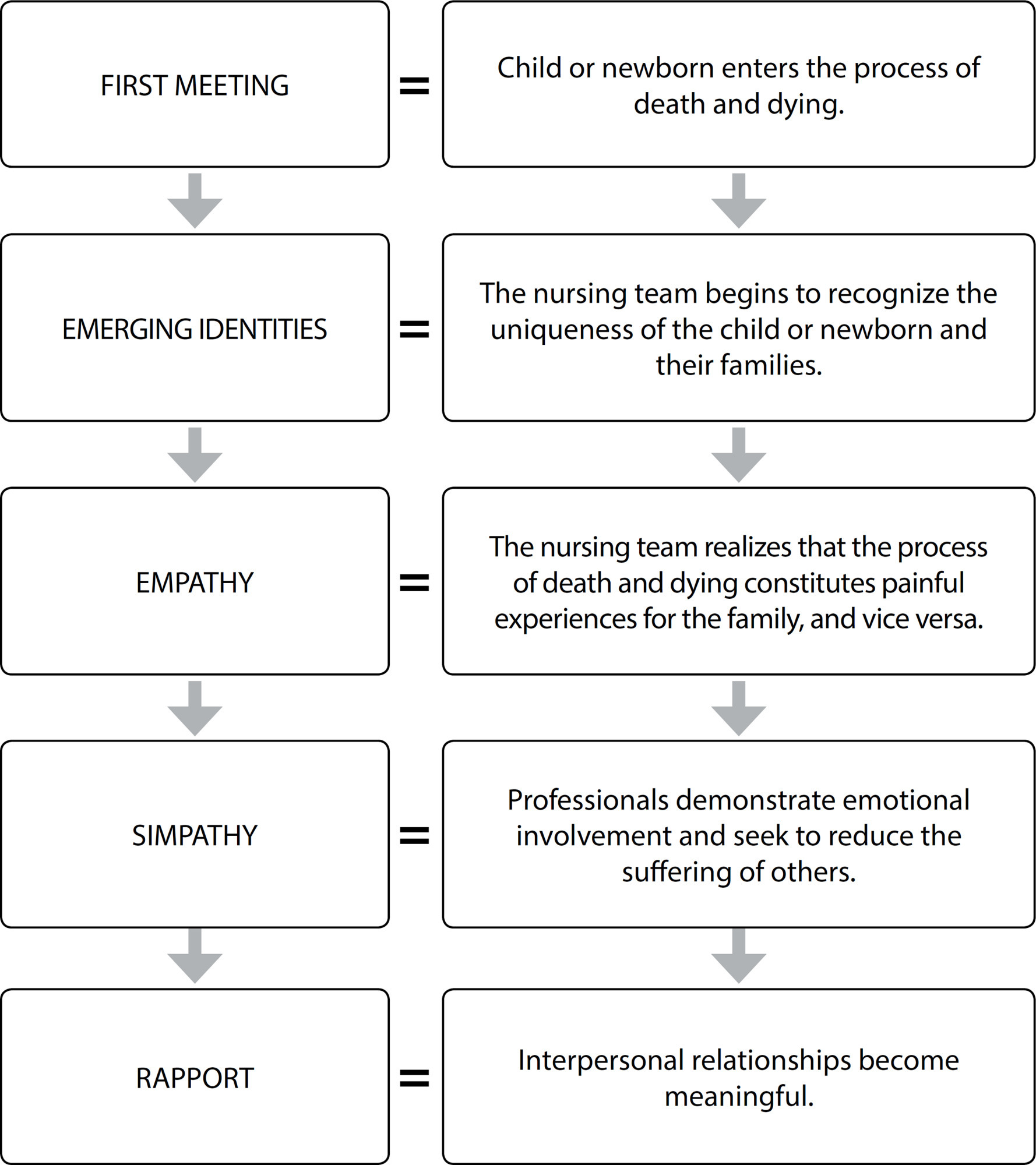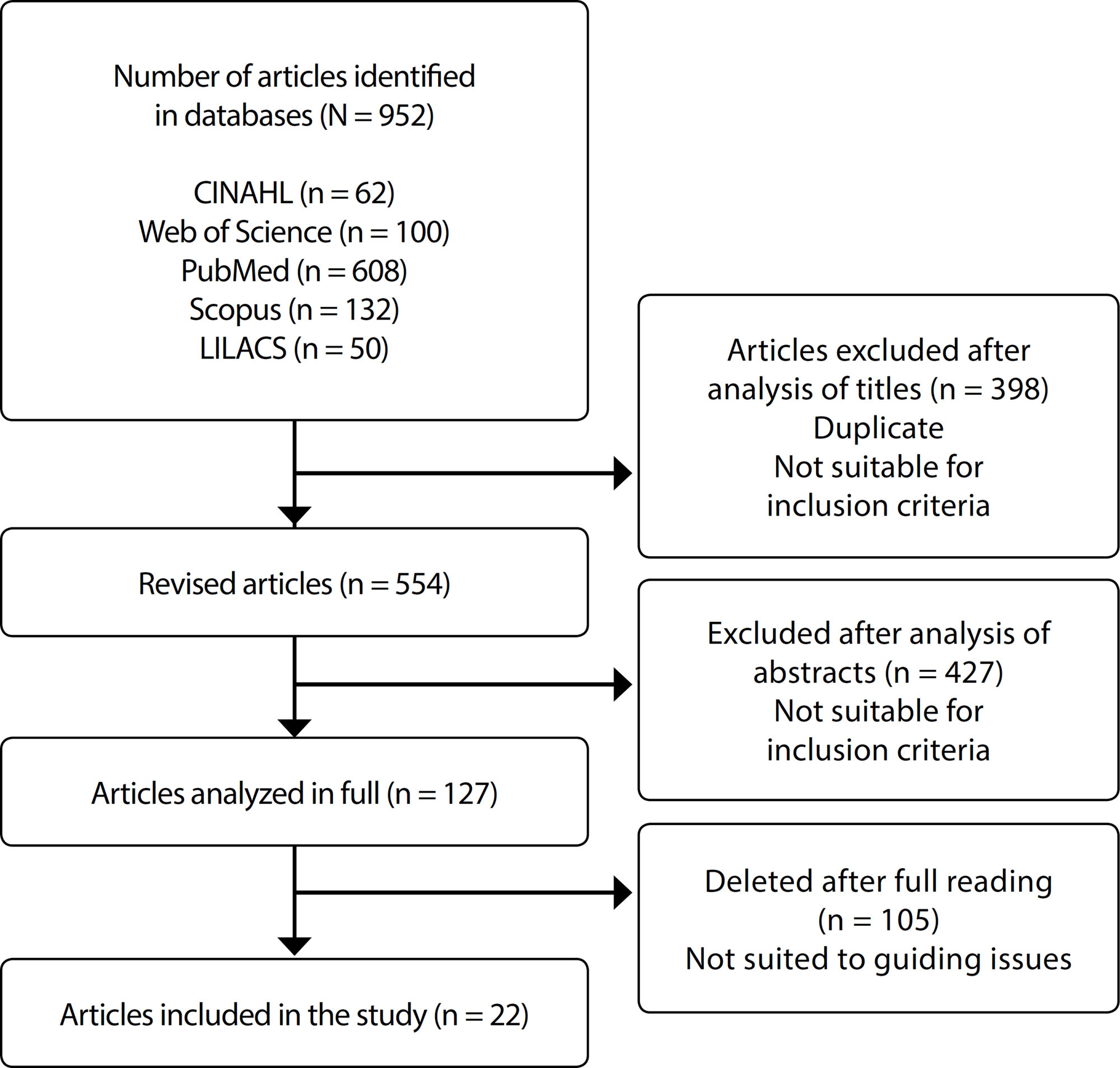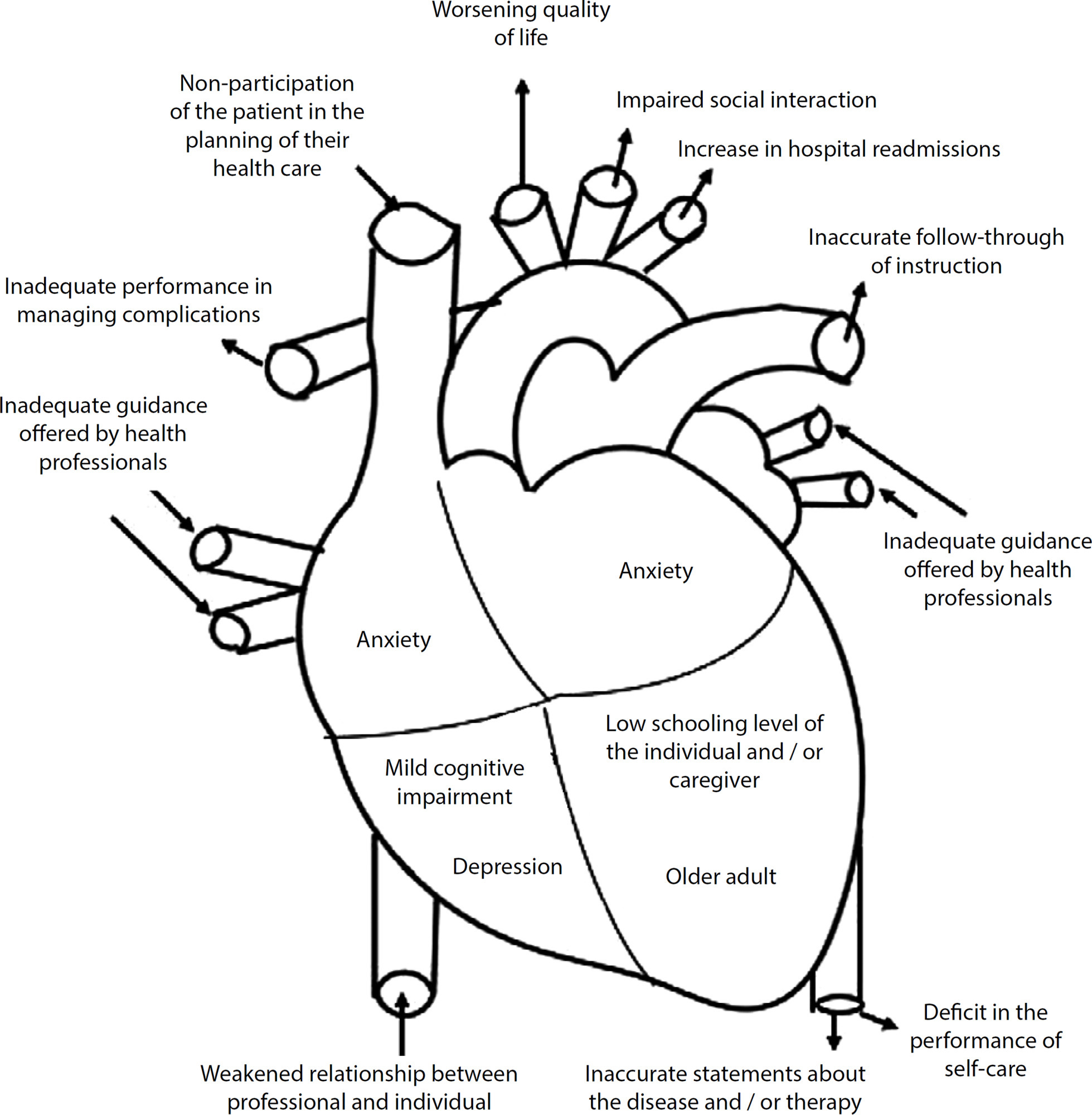-
ORIGINAL ARTICLE10-18-2022
Care related to peripheral intravenous catheterism in pediatrics performed by nursing technicians
Revista Brasileira de Enfermagem. 2022;75(2):e20200611
Abstract
ORIGINAL ARTICLECare related to peripheral intravenous catheterism in pediatrics performed by nursing technicians
Revista Brasileira de Enfermagem. 2022;75(2):e20200611
DOI 10.1590/0034-7167-2020-0611
Views0See moreABSTRACT
Objectives:
to evaluate the care practice adopted by nursing technicians before, during and after peripheral intravenous catheterization performed in hospitalized children.
Methods:
cross-sectional and descriptive research, carried out in a pediatric hospital in Bahia through non-participatory observation of peripheral intravenous catheterizations performed in children by nursing technicians. Data was collected through an instrument containing care related to the moments before, during and after insertion of the catheter, calculating absolute and relative frequencies, measures of central tendency and dispersion.
Results:
there were 31 nursing technicians, who performed care mainly before intravenous catheterization. Nonconformities were identified regarding hand hygiene, use of a disposable mask, selection of the catheter insertion site, antisepsis, stabilization and catheter coverage.
Conclusions:
most of the precautions observed regarding peripheral intravenous catheterization are not in accordance with the standards of practice recommended by the national and international literature.
-
10-18-2022
Clinical progression of COVID-19 coinfection in people living with the human immunodeficiency virus: scoping review
Revista Brasileira de Enfermagem. 2022;75(2):e20201380
Abstract
Clinical progression of COVID-19 coinfection in people living with the human immunodeficiency virus: scoping review
Revista Brasileira de Enfermagem. 2022;75(2):e20201380
DOI 10.1590/0034-7167-2020-1380
Views0See moreABSTRACT
Objectives:
to map the production of scientific knowledge on the clinical progression of COVID-19 coinfection in people living with the human immunodeficiency virus (HIV).
Methods:
scoping review, with search strategies in MEDLINE, Scopus, Embase, Web of Science, and LILACS. Dual independent data extraction and analysis of the material with similarity compilation and narrative synthesis.
Results:
sample consisted of 35 articles. Fever, cough, and dyspnea were the most prevalent signs/symptoms. Recurrent complications involved desaturation/worsening of oxygen desaturation and pneumonia. No standard pharmacological treatment was identified, and the main interventions involved the provision of supplemental oxygen and mechanical ventilation. The studies recommended preventive, care, and pharmacological practices.
Conclusions:
the clinical manifestations, complications, and treatments/assistance care for people coinfected with SARS CoV-2/HIV are similar to those of the general population. Coinfection, overall, does not infer a worse prognosis.

-
ORIGINAL ARTICLE10-18-2022
Death and dying of newborns and children: relationships between nursing and family according to Travelbee
Revista Brasileira de Enfermagem. 2022;75(2):e20210007
Abstract
ORIGINAL ARTICLEDeath and dying of newborns and children: relationships between nursing and family according to Travelbee
Revista Brasileira de Enfermagem. 2022;75(2):e20210007
DOI 10.1590/0034-7167-2021-0007
Views0See moreABSTRACT
Objective:
Identify the nursing staff’s perception of their relationship with families of newborns and children who are in the process of death and dying.
Methods:
Qualitative research, carried out in the Neonatal and Pediatric Intensive Care Unit of a public maternity hospital in Rio Grande do Norte, with 17 nursing professionals, through a semi-structured interview. After being transcribed, the data were subjected to Bardin’s content analysis and interpreted in the light of the theory of Interpersonal Relations proposed by Travelbee.
Results:
Four categories emerged from the analysis: “Caring and welcoming people, feelings and stories”; “Reactions in the midst of pain: moving between acceptance and suffering”; “Communication of bad news: challenges and strategies”; “The weight of caring and suffering”.
Final considerations:
Family assistance can be established using Travelbee’s principles, as they offer timely theoretical support for nursing actions in the context of the process of death and dying.

-
ORIGINAL ARTICLE10-18-2022
Health education for hospitalized patient in nursing care: a conceptual analysis
Revista Brasileira de Enfermagem. 2022;75(2):e20200459
Abstract
ORIGINAL ARTICLEHealth education for hospitalized patient in nursing care: a conceptual analysis
Revista Brasileira de Enfermagem. 2022;75(2):e20200459
DOI 10.1590/0034-7167-2020-0459
Views0INTRODUCTIONOver the years, the development of health education practices is related to the historical moment of society(). The nineteenth and twentieth centuries presented decisive situations in the evolution process that we know today as health education. Nursing began to consider health educational practices after Florence Nightingale initially focused on professional training. Florence contributed to the […]See more
-
ORIGINAL ARTICLE10-18-2022
Impaired knowledge in individuals with heart failure: a middle range nursing theory
Revista Brasileira de Enfermagem. 2022;75(2):e20200855
Abstract
ORIGINAL ARTICLEImpaired knowledge in individuals with heart failure: a middle range nursing theory
Revista Brasileira de Enfermagem. 2022;75(2):e20200855
DOI 10.1590/0034-7167-2020-0855
Views0See moreABSTRACT
Objective:
To develop a middle range nursing theory of impaired knowledge in individuals with heart failure.
Methods:
Descriptive study of the cross type developed through the theoretical-causal validity method, which used six steps for theory building: Definition of the construction approach; Definition of theoretical-conceptual models; Definition of main concepts; Development of a pictorial scheme; Construction of propositions; and Establishment of causal relations and evidence for practice.
Results:
Twenty-four articles were found, which identified two attributes, eight antecedents, and seven consequences, which gave rise to the pictogram, which schematized the concepts by relating them to cardiac physiology. Finally, 11 propositions and four causal relationships were created.
Conclusion:
The constructed theory enables a targeted driving of nurses’ clinical judgment regarding impaired knowledge in individuals with heart failure, culminating in individualized interventions to improve quality of life.

-
ORIGINAL ARTICLE10-18-2022
Adherence to antiretroviral therapy by adults living with HIV/aids: a cross-sectional study
Revista Brasileira de Enfermagem. 2022;75(2):e20210019
Abstract
ORIGINAL ARTICLEAdherence to antiretroviral therapy by adults living with HIV/aids: a cross-sectional study
Revista Brasileira de Enfermagem. 2022;75(2):e20210019
DOI 10.1590/0034-7167-2021-0019
Views0See moreABSTRACT
Objective:
To verify the association between adherence to antiretroviral treatment by adults with HIV/AIDS and sociodemographic factors, social and clinical support.
Methods:
Cross-sectional study, with a quantitative approach. Participation of 230 patients. Questionnaires of sociodemographic characterization, social and clinical support, and assessment of adherence to antiretroviral treatment were used. Descriptive and inferential statistics were performed.
Results:
Adherence was classified as good/adequate. An association with sex, income, employment, and level of education was noted. In social support: having access to health services; communication with health professionals; health education; having support to allow venting/talking about issues; information on HIV/AIDS; and company for leisure. In the clinical profile: non-interruption of the drug treatment due to absence from the service or due to changes in the medical prescription.
Conclusion:
Adherence was classified as good/adequate and especially associated with social support factors, which should be enhanced in clinical practice.
-
ORIGINAL ARTICLE10-18-2022
Professional Safety in the daily life of primary health care: grounded theory
Revista Brasileira de Enfermagem. 2022;75(2):e20210033
Abstract
ORIGINAL ARTICLEProfessional Safety in the daily life of primary health care: grounded theory
Revista Brasileira de Enfermagem. 2022;75(2):e20210033
DOI 10.1590/0034-7167-2021-0033
Views0See moreABSTRACT
Objective:
to understand Professional Safety in daily life in Primary Health Care.
Methods:
this is a study on the Grounded Theory method and the Symbolic Interactionism theoretical framework with 82 health professionals.
Results:
it presents the category “Professional Safety in Daily Life in Primary Health Care: a Grounded Theory” and two subcategories determining and conditioning Professional Safety in PHC: professional training, infrastructure, support and technical responsibility; Professional Safety: physical protection, psychological support, distress and feelings reveal the (un)safe conditions. Professional Safety is mentioned in several dimensions that include professionals’ knowledge, decision-making skills, the practice of the profession and what regulates it, the structure and organization of the Unified Health System and services, permanent education. It presents the context of primary care and the factors that impact an (unsafe) work.
Final considerations:
this study contributes to reflect on Professional Safety to strengthen safety culture in Primary Health Care.

-
ORIGINAL ARTICLE10-18-2022
Quality of life of nurse practitioners during the COVID-19 pandemic
Revista Brasileira de Enfermagem. 2022;75:e20201382
Abstract
ORIGINAL ARTICLEQuality of life of nurse practitioners during the COVID-19 pandemic
Revista Brasileira de Enfermagem. 2022;75:e20201382
DOI 10.1590/0034-7167-2020-1382
Views0See moreABSTRACT
Objective:
to assess the quality of life of nurse practitioners during the COVID-19 pandemic and analyze related factors.
Methods:
cross-sectional and analytical study carried out with nurse practitioners. A questionnaire on sociodemographic characterization, work activities and changes perceived with the pandemic and WHOQOL-bref were used. To compare the groups of interest, analysis of covariance was used.
Results:
572 professionals participated, who had a mean total quality of life score of 56.79 (SD=13.56). In the relationship of variables with WHOQOL-bref, having two or more jobs and being a nurse were associated with better quality of life, but being a woman and working more than 50 hours a week was associated with a worse perception of the construct.
Conclusions:
the factors analyzed indicate a lower perception of quality of life associated with the social domain, requiring interventions that reduce the damage to professionals’ health and contribute to quality of care provided.
-
EXPERIENCE REPORT01-01-2018
Clinical and epidemiological teaching of dengue through simulated practice
Revista Brasileira de Enfermagem. 2018;71(2):451-456
Abstract
EXPERIENCE REPORTClinical and epidemiological teaching of dengue through simulated practice
Revista Brasileira de Enfermagem. 2018;71(2):451-456
DOI 10.1590/0034-7167-2016-0503
Views2See moreABSTRACT
Objective:
to describe the experience of clinical teaching on dengue and the practice of epidemiological surveillance using problematization methodology.
Method:
report of experience on educational activity with undergraduate nursing students, held in March 2016, at a public university in the city of São Paulo, conceived in four stages: dialogic lecture, active search of Aedes aegypti, case study and simulation of nursing consultation to individuals with dengue.
Results:
The activity allowed to retrieve previous knowledge about the disease, respond to exercises that addressed different clinical situations and epidemiological surveillance, including in situ evaluation of possible mosquito outbreaks, and discuss the need to expand prevention and health of the individual and the community, the impact of the media in the dissemination of cases and the coping difficulties experienced in the different levels of attention.
Conclusion:
the methodology adopted enabled qualified training of students to cope with dengue.

-
ORIGINAL ARTICLE07-18-2022
Beliefs, knowledge, actions of nursing techniques in breastfeeding in pain management in immunization
Revista Brasileira de Enfermagem. 2022;75(6):e20210546
Abstract
ORIGINAL ARTICLEBeliefs, knowledge, actions of nursing techniques in breastfeeding in pain management in immunization
Revista Brasileira de Enfermagem. 2022;75(6):e20210546
DOI 10.1590/0034-7167-2021-0546
Views1See moreABSTRACT
Objective:
Understand the beliefs, knowledge, and actions of nursing technicians on breastfeeding as a form of non-pharmacological intervention to relieve pain in newborns and infants during immunization.
Methods:
Qualitative study carried out through semi-structured interviews with nine nursing technicians from three Basic Health Units in a city in the state of São Paulo. The theoretical approach of the Belief Model and the methodological framework of Thematic Analysis supported this study.
Results:
Three themes originated: Beliefs, Knowledge, and Actions of nursing technicians.
Final considerations:
Despite knowledge about the benefits of breastfeeding as the most effective method for relieving pain in newborns and infants during vaccination, their restrictive beliefs overrode the evidence, leading them to act in ways that discourage or prevent the mother from breastfeed during vaccination. Formal training is recommended to align with current evidence-based practices.
-
REVIEW12-08-2023
Educational technologies for accident prevention due to falls in childhood: a scoping review
Revista Brasileira de Enfermagem. 2023;76:e20220807
Abstract
REVIEWEducational technologies for accident prevention due to falls in childhood: a scoping review
Revista Brasileira de Enfermagem. 2023;76:e20220807
DOI 10.1590/0034-7167-2022-0807
Views2See moreABSTRACT
Objectives:
to map evidence on educational technology use for accident prevention due to falls in childhood.
Methods:
a scoping review, carried out in October and November 2022, in the MEDLINE, Web of Science, BDENF and CINAHL databases and LILACS bibliographic index. There was no delimitation of language or time. Data were extracted and analyzed descriptively by two independent researchers. The research protocol was registered in the Open Science Framework.
Results:
twenty-six studies were selected. Booklets, pamphlets and leaflets were the most used technologies, presenting health services as the most frequent environment to develop research on fall prevention. The technologies developed were important outcomes: increased knowledge of children, family members, caregivers, health and education professionals.
Conclusions:
educational technology use makes it possible to increase knowledge, adopt safe practices and reduce falls.

-
REVIEW03-15-2024
Resources for health literacy among caregivers of prematurely born children: a scoping review
Revista Brasileira de Enfermagem. 2024;77(1):e20230062
Abstract
REVIEWResources for health literacy among caregivers of prematurely born children: a scoping review
Revista Brasileira de Enfermagem. 2024;77(1):e20230062
DOI 10.1590/0034-7167-2023-0062
Views1See moreABSTRACT
Objectives:
to map the available evidence on resources used to promote health literacy among caregivers of prematurely born children during outpatient follow-up.
Methods:
the Joanna Briggs Institute’s scope review protocol was utilized. The search encompassed six databases, incorporating studies from 2012 to 2022.
Results:
the three included publications revealed that the resources employed are: mobile applications, phone calls, individual counseling, videos, educational pamphlets, and group discussions. Implementing an education protocol during the transition home enhances scientifically grounded health promotion rates.
Conclusions:
there is limited literature addressing the health literacy of these caregivers. The nursing team plays a crucial role in health education and in developing resources applicable to these families.

-
ORIGINAL ARTICLE01-13-2024
Social representations of oncologic surgery for patients with cancer
Revista Brasileira de Enfermagem. 2024;77(6):e20230273
Abstract
ORIGINAL ARTICLESocial representations of oncologic surgery for patients with cancer
Revista Brasileira de Enfermagem. 2024;77(6):e20230273
DOI 10.1590/0034-7167-2023-0273
Views2See moreABSTRACT
Objectives:
to analyze the social representations of patients with cancer regarding oncologic surgery.
Methods:
a qualitative study based on Social Representation Theory was conducted with 126 participants between October 2021 and May 2022 in a public hospital in Rio de Janeiro. A characterization questionnaire, free evocations of the inducing term “surgery”, and semi-structured interviews with 60 participants were applied. Data were analyzed using Microsoft Excel® and IRaMuTeQ.
Results:
the central core of the representation is composed of fear, cure, hope, and removing the disease. The analysis of interviews resulted in six classes that highlight the social changes caused by treatment as well as the need for a support network to cope with the surgical process.
Final Considerations:
the representations reflect fear and hope towards the procedure and the desire to remove the disease, thus translating the cure through surgery.

-
ORIGINAL ARTICLE01-13-2024
Nurses’ perspectives on the use of telemonitoring in the management of people with diabetes and hypertension
Revista Brasileira de Enfermagem. 2024;77(6):e20230481
Abstract
ORIGINAL ARTICLENurses’ perspectives on the use of telemonitoring in the management of people with diabetes and hypertension
Revista Brasileira de Enfermagem. 2024;77(6):e20230481
DOI 10.1590/0034-7167-2023-0481
Views3See moreABSTRACT
Objectives:
to understand the perspective of nurses on the use of telemonitoring in the management of people with type 2 diabetes mellitus and arterial hypertension in primary care.
Methods:
this qualitative research involved sixteen nurses from eight municipalities in Paraná. Data were collected between November 2022 and January 2023 through inperson or remote interviews, which were audio-recorded and subjected to content analysis.
Results:
according to the nurses, telemonitoring enhances users’ knowledge about these conditions, communication and connection with the team, and productivity. However, the lack of electronic resources and equipment, high staff turnover, low user adherence, and the limited availability of professional time present significant challenges.
Final Considerations:
the effective implementation and operation of telemonitoring in the management of people with diabetes and hypertension involve both potential benefits and barriers. It is essential to have the availability of human and technological resources, managerial support, and the commitment of professionals and users.
-
ERRATUM01-13-2024
ERRATUM
Revista Brasileira de Enfermagem. 2024;77(6):e2024n6e08
Abstract
ERRATUMERRATUM
Revista Brasileira de Enfermagem. 2024;77(6):e2024n6e08
DOI 10.1590/0034-7167.20247706e08
Views2In the article “Brazilian nursing specific situation, middle and micro-range theories: a bibliometric study”, with DOI number: , published in Revista Brasileira de Enfermagem, 2024;77(4):e20230520, Chart 1:Where it read:[…]See more -
ORIGINAL ARTICLE09-29-2022
Palliative care production for health professionals in the context of home care
Revista Brasileira de Enfermagem. 2022;75(1):e20210030
Abstract
ORIGINAL ARTICLEPalliative care production for health professionals in the context of home care
Revista Brasileira de Enfermagem. 2022;75(1):e20210030
DOI 10.1590/0034-7167-2021-0030
Views1See moreABSTRACT
Objectives:
to analyze palliative care production developed by health professionals to home care patients.
Methods:
this is an exploratory study, with a qualitative approach, using the transpersonal care theoretical framework. Thirteen interviews were conducted with health professionals and 18 observations were conducted on different cases. Content analysis was performed using MAXQDA©.
Results:
actions performed: maintenance and follow-up measures to people eligible for palliative care, in acts of dialogue and “listening” to caregivers and users, conducting guidelines for the care and self-care process, performing technical procedures, delivery of materials, referrals and medical prescriptions to users.
Final Considerations:
it is perceived the need for advances in the implementation of government policies in Brazil that insert palliative care into the Health Care Network through educational, managerial and care actions that ensure human dignity, thus allowing the development of these and other palliative care interventions.
Search
Search in:
Nuvem de Tags
Enfermagem (930)Cuidados de Enfermagem (269)Atenção Primária à Saúde (239)Idoso (208)Educação em Enfermagem (151)Segurança do Paciente (150)Saúde Mental (145)Educação em Saúde (139)Estudos de Validação (131)Qualidade de Vida (104)Tecnologia Educacional (100)Promoção da Saúde (99)COVID-19 (91)Criança (91)Família (87)Enfermagem Pediátrica (86)Saúde do Trabalhador (86)Adolescente (85)Saúde Pública (82)Estudantes de Enfermagem (77)



